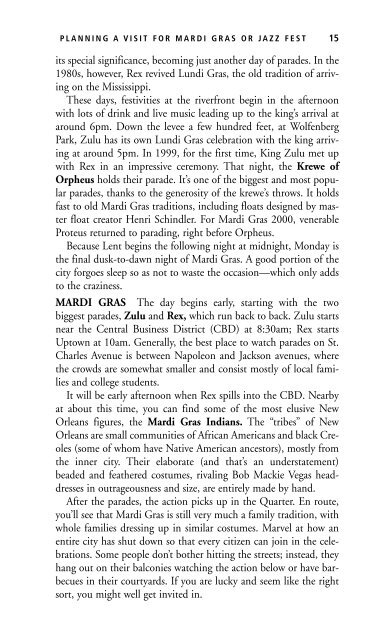Create successful ePaper yourself
Turn your PDF publications into a flip-book with our unique Google optimized e-Paper software.
PLANNING A VISIT FOR MARDI GRAS OR JAZZ FEST 15<br />
its special significance, becoming just another day of parades. In the<br />
1980s, however, Rex revived Lundi Gras, the old tradition of arriving<br />
on the Mississippi.<br />
These days, festivities at the riverfront begin in the afternoon<br />
with lots of drink and live music leading up to the king’s arrival at<br />
around 6pm. Down the levee a few hundred feet, at Wolfenberg<br />
Park, Zulu has its own Lundi Gras celebration with the king arriving<br />
at around 5pm. In 1999, for the first time, King Zulu met up<br />
with Rex in an impressive ceremony. That night, the Krewe of<br />
Orpheus holds their parade. It’s one of the biggest and most popular<br />
parades, thanks to the generosity of the krewe’s throws. It holds<br />
fast to old Mardi Gras traditions, including floats designed by master<br />
float creator Henri Schindler. For Mardi Gras 2000, venerable<br />
Proteus returned to parading, right before Orpheus.<br />
Because Lent begins the following night at midnight, Monday is<br />
the final dusk-to-dawn night of Mardi Gras. A good portion of the<br />
city forgoes sleep so as not to waste the occasion—which only adds<br />
to the craziness.<br />
MARDI GRAS The day begins early, starting with the two<br />
biggest parades, Zulu and Rex, which run back to back. Zulu starts<br />
near the Central Business District (CBD) at 8:30am; Rex starts<br />
Uptown at 10am. Generally, the best place to watch parades on St.<br />
Charles Avenue is between Napoleon and Jackson avenues, where<br />
the crowds are somewhat smaller and consist mostly of local families<br />
and college students.<br />
It will be early afternoon when Rex spills into the CBD. Nearby<br />
at about this time, you can find some of the most elusive <strong>New</strong><br />
<strong>Orleans</strong> figures, the Mardi Gras Indians. The “tribes” of <strong>New</strong><br />
<strong>Orleans</strong> are small communities of African Americans and black Creoles<br />
(some of whom have Native American ancestors), mostly from<br />
the inner city. Their elaborate (and that’s an understatement)<br />
beaded and feathered costumes, rivaling Bob Mackie Vegas headdresses<br />
in outrageousness and size, are entirely made by hand.<br />
After the parades, the action picks up in the Quarter. En route,<br />
you’ll see that Mardi Gras is still very much a family tradition, with<br />
whole families dressing up in similar costumes. Marvel at how an<br />
entire city has shut down so that every citizen can join in the celebrations.<br />
Some people don’t bother hitting the streets; instead, they<br />
hang out on their balconies watching the action below or have barbecues<br />
in their courtyards. If you are lucky and seem like the right<br />
sort, you might well get invited in.


